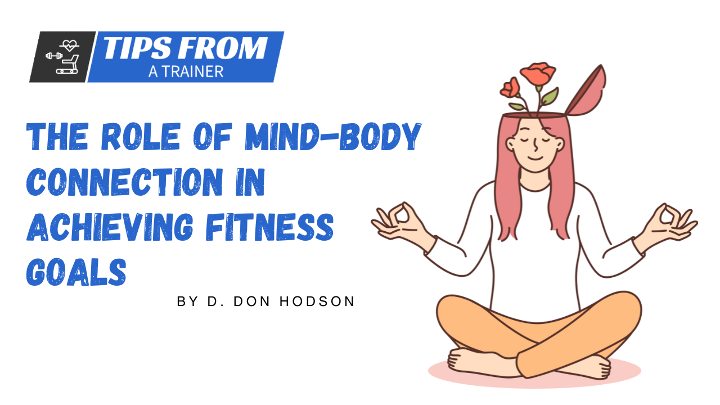Introduction
The Mind-Body Connection: An Integral Aspect of Fitness
The journey towards fitness encompasses more than just physical exertion; it delves into the intricate interplay between mind and body. The mind-body connection, a fundamental concept in health and well-being, underscores the profound influence of our mental state on our physical state, and vice versa. It is a symbiotic relationship where thoughts, emotions, and physiological responses are intertwined, shaping our overall health and shaping our progress in achieving fitness goals.
Significance of Exploring the Mind-Body Relationship
In a world where fitness is often equated solely with physical prowess, delving into the mind-body connection holds paramount importance. Understanding how our thoughts, feelings, and attitudes affect our physical capabilities can lead to a more holistic approach to fitness. By harnessing the power of the mind-body connection, individuals can unlock new dimensions of wellness, enriching not only their exercise routines but their entire lives.
Article Purpose: The Role of Mind-Body Connection in Fitness Success
The purpose of this article is to embark on a comprehensive exploration of the role that the mind-body connection plays in achieving fitness goals. By examining the science behind this connection and unveiling various techniques and strategies, we aim to equip readers with the knowledge and tools they need to harness the mind-body synergy for optimal fitness outcomes. From understanding the science to implementing practical applications, this article seeks to empower individuals to elevate their fitness journey through a harmonious fusion of mind and body.
Table of Contents
Introduction
The Mind-Body Connection: An Integral Aspect of Fitness
Significance of Exploring the Mind-Body Relationship
Article Purpose: Unraveling the Role of Mind-Body Connection in Fitness Success
Understanding the Mind-Body Connection
What is the Mind-Body Connection?
The Science Behind the Mind-Body Link
Mind-Body Awareness: Tuning into Your Inner Signals
Mental Techniques for Enhancing Physical Performance
Visualization: Harnessing the Power of Mental Imagery
Positive Affirmations: Cultivating a Supportive Inner Dialogue
Goal Setting: Directing Your Mind towards Fitness Success
Stress Management and Its Impact on Physical Well-being
The Stress-Exercise Connection: How Stress Affects the Body
Stress Reduction Strategies: Techniques for Relaxation and Balance
Mindfulness Meditation: Fostering Present-Moment Awareness
Emotions and Exercise: Navigating the Feelings-Fitness Nexus
Emotional Well-being and Physical Activity: A Bidirectional Relationship
Using Exercise to Regulate Emotions: The Role of Endorphins
Mindful Movement: Engaging Emotions through Purposeful Exercise
Overcoming Mental Barriers: Confidence and Self-Efficacy
Building Self-Confidence: Recognizing and Challenging Limiting Beliefs
Self-Efficacy in Fitness: Believing in Your Capacity to Succeed
Positive Self-Talk: Cultivating a Supportive Inner Coach
Integrating Mindfulness into Physical Training
Mindful Eating: Savoring Food and Nurturing Nutritional Choices
Mindful Workouts: Cultivating Presence during Exercise
Breath Awareness: Enhancing Mind-Body Synchrony
The Mind-Body Connection in Long-Term Fitness Success
Consistency and Motivation: Nurturing the Mind-Body Partnership
Holistic Well-being: Beyond Physical Fitness
Empowerment through Mind-Body Mastery
Conclusion
Embracing the Mind-Body Connection: Elevating Your Fitness Journey
Achieving Your Fitness Goals: Cultivating Harmony between Mind and Body

Understanding the Mind-Body Connection
What is the Mind-Body Connection?
The mind-body connection refers to the intricate relationship between mental and physical states, where each influences and interacts with the other. This connection underscores the notion that the mind and body are not isolated entities but rather intertwined aspects of an integrated whole. Thoughts, emotions, and beliefs can have a profound impact on physical health, influencing everything from immune function and metabolism to pain perception and muscle tension.
The Science Behind the Mind-Body Link
Scientifically, the mind-body connection finds its roots in the field of psychoneuroimmunology, which studies the interactions between psychological processes, the nervous system, and the immune system. Research has revealed that stress, for instance, can trigger a cascade of physiological responses that impact immune function and inflammation. Furthermore, positive emotions and attitudes have been shown to contribute to better cardiovascular health and enhanced overall well-being.
Mind-Body Awareness: Tuning into Your Inner Signals
Tuning into the mind-body connection involves cultivating mindfulness—an awareness of one's thoughts, emotions, and bodily sensations. Mindfulness allows individuals to observe their mental and physical states without judgment, facilitating a deeper understanding of how these elements influence each other. Practicing mindfulness can lead to enhanced self-awareness, which, in turn, aids in recognizing the subtle cues that the body provides, such as signals of fatigue, stress, or even excitement. By fostering mind-body awareness, individuals can make informed decisions about their fitness routines and respond to their body's needs with greater sensitivity.
Mental Techniques for Enhancing Physical Performance
Visualization
Visualization is a cognitive technique that involves creating vivid mental images of a desired outcome. It serves as a bridge between imagination and reality, allowing individuals to rehearse successful performances in their minds before they are physically executed. When applied to the realm of fitness, visualization can be a potent tool for enhancing physical performance. By mentally rehearsing exercises, movements, or routines, individuals can activate neural pathways that stimulate muscle memory and coordination. Moreover, visualization can help reduce anxiety and increase self-confidence, as individuals become familiar with the sensations associated with successful execution.
Positive Affirmations
Positive affirmations involve the repetition of empowering statements that foster a supportive inner dialogue. This practice can be particularly impactful in the context of physical performance. By replacing self-doubt and negative self-talk with affirmations that emphasize strength, capability, and determination, individuals can bolster their self-belief and motivation. Over time, these affirmations become ingrained in the subconscious mind, influencing behavior and reinforcing a positive mindset. The power of positive affirmations lies in their ability to shape perceptions, leading to increased confidence, resilience, and an enhanced sense of self-worth.
Goal Setting
Goal setting is a cognitive process through which individuals define specific objectives and outline a plan to achieve them. While fitness goals often center around physical outcomes, such as weight loss or muscle gain, the process of goal setting itself is deeply rooted in the mind-body connection. By setting clear and achievable goals, individuals direct their mental focus towards a desired outcome. This concentration of attention propels motivation, encourages disciplined effort, and fosters a sense of purpose. Additionally, goal setting provides a framework for measuring progress, which can further enhance self-efficacy and confidence as milestones are reached.
Stress Management and Its Impact on Physical Well-being
The Stress-Exercise Connection
Stress, a prevalent aspect of modern life, has a profound impact on both mental and physical health. When the body experiences stress, whether from work, relationships, or other sources, it triggers a physiological response known as the "fight-or-flight" response. This response releases stress hormones, such as cortisol and adrenaline, which prepare the body for immediate action. However, chronic or excessive stress can disrupt this delicate balance, leading to negative consequences for overall well-being. In the context of exercise, stress can manifest as physical tension, muscle stiffness, and impaired recovery, ultimately hindering fitness progress.
Stress Reduction Strategies
To mitigate the adverse effects of stress on physical well-being, stress reduction strategies are crucial. Techniques such as deep breathing exercises, progressive muscle relaxation, and mindfulness-based stress reduction can help individuals manage stress levels and promote relaxation. Engaging in regular physical activity itself serves as a potent stress reducer, as exercise triggers the release of endorphins—neurochemicals that induce feelings of pleasure and reduce stress. Moreover, maintaining a balanced lifestyle that includes adequate sleep, healthy nutrition, and social support can contribute to stress resilience and enhance the body's capacity to cope with challenges.
Mindfulness Meditation
Mindfulness meditation, derived from ancient contemplative traditions, has gained recognition as an effective stress management tool. Mindfulness involves cultivating present-moment awareness and accepting one's thoughts and feelings without judgment. Regular mindfulness practice has been shown to reduce stress, anxiety, and symptoms of depression. In the context of fitness, mindfulness meditation can be particularly beneficial for fostering a mind-body connection. By focusing attention on the sensations of movement, breath, and muscle engagement during exercise, individuals can enhance their awareness of physical sensations and promote a state of flow. This heightened state of awareness can contribute to improved movement quality, reduced risk of injury, and a deeper connection to the body's signals.
Emotions and Exercise: Navigating the Feelings-Fitness Nexus
Emotional Well-being and Physical Activity
Emotions, the intricate fabric of human experience, are not confined to the realm of the mind; they exert a profound influence on physical activity. The dynamic relationship between emotions and exercise is bidirectional, meaning that emotions can shape our engagement in physical activities, and in turn, exercise can impact our emotional well-being. Engaging in regular physical activity has been shown to have a positive impact on mood and emotional states. Exercise prompts the release of endorphins, neurotransmitters that act as natural painkillers and mood enhancers, leading to feelings of euphoria and reduced stress. Furthermore, physical activity provides a productive outlet for managing negative emotions, offering a healthy means of coping with stress, anxiety, and even mild depression. This intricate interplay highlights the intricate ways in which emotions and exercise converge, forming an integral aspect of the mind-body connection.
Using Exercise to Regulate Emotions
The ability of exercise to regulate emotions goes beyond its immediate effects on neurotransmitter release. Engaging in physical activity triggers a cascade of physiological responses that contribute to emotional regulation. For instance, elevated heart rate and increased blood flow during exercise can stimulate the body's relaxation response, leading to a reduction in stress and anxiety. Moreover, the act of focusing on the body's movements and sensations during exercise can divert attention away from distressing thoughts, providing a temporary reprieve from emotional turmoil. The sustained practice of using exercise as a tool for emotional regulation can foster resilience, improve emotional coping strategies, and contribute to overall well-being.
Mindful Movement
Mindful movement, an approach that integrates mindfulness with physical activity, bridges the gap between emotions and exercise by fostering intentional awareness of the body and its sensations during movement. Mindfulness encourages individuals to engage with exercise in the present moment, heightening sensory perception and deepening the mind-body connection. By immersing oneself in the experience of movement, individuals become attuned to the rhythmic flow of breath, the sensations of muscle engagement, and the rhythm of heartbeats. This heightened awareness allows individuals to navigate emotions with intention, utilizing movement as a means to process and express feelings. Furthermore, mindful movement nurtures an embodied sense of self, facilitating emotional expression through purposeful and deliberate physical actions.
Overcoming Mental Barriers: Confidence and Self-Efficacy
Building Self-Confidence
Self-confidence, the bedrock of success, is a deeply rooted psychological construct that profoundly influences an individual's pursuit of fitness goals. Building self-confidence involves a multifaceted process of recognizing, challenging, and reframing limiting beliefs. Limiting beliefs are self-imposed mental barriers that undermine confidence and impede progress. Recognizing these beliefs is the first step towards dismantling them. Through introspection, individuals can identify patterns of negative self-talk and thought distortions that perpetuate self-doubt. Once identified, these beliefs can be challenged by seeking evidence to the contrary, reframing negative thoughts into neutral or positive statements, and cultivating a realistic and balanced perspective.
Self-Efficacy in Fitness
Self-efficacy, a concept pioneered by psychologist Albert Bandura, refers to an individual's belief in their capacity to successfully execute specific actions required to achieve desired outcomes. In the context of fitness, self-efficacy influences the willingness to engage in exercise, persist through challenges, and recover from setbacks. Developing self-efficacy involves a gradual process of mastery experiences, vicarious learning, social persuasion, and emotional arousal. Setting achievable fitness goals and progressively accomplishing them serves as a foundation for self-efficacy. Witnessing the success of others and receiving encouragement from peers and trainers can also bolster self-efficacy. Additionally, managing emotional states during exercise, such as anxiety or frustration, contributes to a sense of mastery and self-assuredness.
Positive Self-Talk
Positive self-talk, the practice of using affirming and encouraging language towards oneself, is a potent tool for cultivating a supportive inner coach. The inner dialogue that accompanies physical activity significantly impacts an individual's confidence, motivation, and performance. Negative self-talk, characterized by self-criticism and self-doubt, can hinder progress and reinforce limiting beliefs. Positive self-talk counteracts this by nurturing a constructive and compassionate internal narrative. Replacing self-deprecating thoughts with empowering statements can bolster self-confidence, reframe challenges as opportunities for growth, and promote a resilient mindset. The repetition of positive affirmations during exercise primes the mind for success, fostering a sense of self-worth and reinforcing the mind-body connection.
Integrating Mindfulness into Physical Training
Mindful Eating
Mindful eating, an essential component of the mind-body connection, invites individuals to cultivate a heightened awareness of their relationship with food. In today's fast-paced world, eating has often become a rushed and mindless activity. However, mindful eating encourages a deliberate and present-minded approach to nourishment. By engaging the senses and focusing attention on the colors, textures, flavors, and aromas of each bite, individuals can foster a deeper connection with their food. This practice not only enhances the sensory experience of eating but also facilitates a more conscious choice of foods. Tuning into hunger and fullness cues helps prevent overeating, and mindful eating can promote a healthier attitude towards food, contributing to overall well-being and the achievement of fitness goals.
Mindful Workouts
The integration of mindfulness into physical exercise amplifies the mind-body connection, enabling individuals to fully engage with their bodies and movements. Mindful workouts involve a deliberate and non-judgmental focus on the sensations, breath, and movements experienced during exercise. This approach encourages individuals to shift their attention away from distractions and external stressors, directing it towards the present moment. By consciously connecting with the body's movements and responses, individuals can optimize exercise techniques, improve form, and reduce the risk of injury. Mindful workouts also provide a respite from the mental clutter that often accompanies daily life, allowing individuals to experience the physical and mental benefits of exercise more fully.
Breath Awareness
Breath awareness, a cornerstone of mindfulness practices, plays a pivotal role in enhancing the mind-body synchrony during workouts. The breath serves as a powerful anchor, connecting the mind and body in a rhythmic and profound way. Paying attention to the breath during exercise promotes oxygenation of muscles, enhances focus, and optimizes energy expenditure. Moreover, conscious breathing aids in reducing stress and anxiety, promoting a state of relaxation conducive to optimal physical performance. Techniques such as deep diaphragmatic breathing and synchronized breathing with movements can elevate the mind-body connection, fostering a sense of harmony and flow during physical training.
The Mind-Body Connection in Long-Term Fitness Success
Consistency and Motivation
Consistency in pursuing fitness goals is intrinsically tied to the strength of the mind-body connection. While external motivators can provide initial bursts of enthusiasm, intrinsic motivation rooted in the mind-body partnership is more likely to lead to sustained success. The alignment of personal values, aspirations, and physical activities nurtures a deeper sense of purpose and commitment. The mind-body connection serves as an internal wellspring of motivation, fueling the desire to engage in regular exercise and make healthy choices. Additionally, the mindfulness practices cultivated throughout the fitness journey, such as visualization, positive self-talk, and breath awareness, can serve as tools to reignite motivation during challenging times.
Holistic Well-being
The mind-body connection extends beyond the realm of physical fitness, embracing holistic well-being that encompasses mental, emotional, and social dimensions. As individuals foster a harmonious relationship between mind and body, they may experience an improved sense of emotional balance, reduced stress levels, enhanced self-esteem, and greater resilience. The ripple effects of this synergy extend to various aspects of life, including relationships, work, and leisure activities. A holistic approach to well-being acknowledges the interconnectedness of mind and body, guiding individuals towards a state of overall equilibrium and fulfillment.
Empowerment through Mind-Body Mastery
The culmination of the mind-body connection is the empowerment that arises from mastering this intricate partnership. As individuals deepen their awareness, cultivate mindfulness, and employ mental techniques, they gain a heightened sense of agency and control over their fitness journey. This empowerment transcends physical achievements, empowering individuals to overcome obstacles, embrace challenges, and persist in the pursuit of their goals. The mastery of the mind-body connection fosters a transformative shift in self-perception, enabling individuals to view themselves as capable, resilient, and adaptable. With this newfound empowerment, individuals are poised to navigate the complexities of their fitness journey and to embody lasting wellness.
Conclusion
Embracing the Mind-Body Connection
The intricate web of connections between the mind and body serves as a foundational element of achieving fitness goals. This multifaceted relationship, encompassing emotions, thoughts, physical sensations, and mindfulness, underscores the profound influence of the mind on physical well-being. Recognizing and embracing the mind-body connection empowers individuals to approach their fitness journey with intention, awareness, and purpose. As they harness mental techniques, manage stress, navigate emotions, and cultivate self-efficacy, individuals create a pathway to holistic wellness that extends far beyond the realm of physical exercise.
Achieving Your Fitness Goals
In the pursuit of fitness goals, the cultivation of harmony between mind and body emerges as an indispensable tool. The mind-body connection propels individuals towards greater self-awareness, resilience, and empowerment. By recognizing the bidirectional relationship between emotions and exercise, engaging in mindful movement, and bolstering confidence and self-efficacy, individuals forge a powerful alliance that sustains their motivation, resilience, and overall well-being. As you embark on your fitness journey, remember that the mind-body connection is a dynamic and evolving partnership that can propel you towards the realization of your aspirations.

Don Hodson, Certified Personal Trainer
I'm Don, an ACE-certified personal trainer and the founder of Tips From A Trainer. With my passion for fitness and years of experience, I've helped countless individuals transform their physiques!
Having personally overcome weight challenges throughout my life, I understand the struggle. Through consistency, exercise, and a balanced diet, I have managed to stay in shape and I want to share my message with the world!
The fitness industry is fraught with misconceptions and deceptive practices, which is why I am committed to providing you with the truth.
- My Site: www.Don-Hodson.com
- My Company: www.ConnectedAgeMarketing.com

The Role of Mind-Body Connection in Achieving Fitness Goals